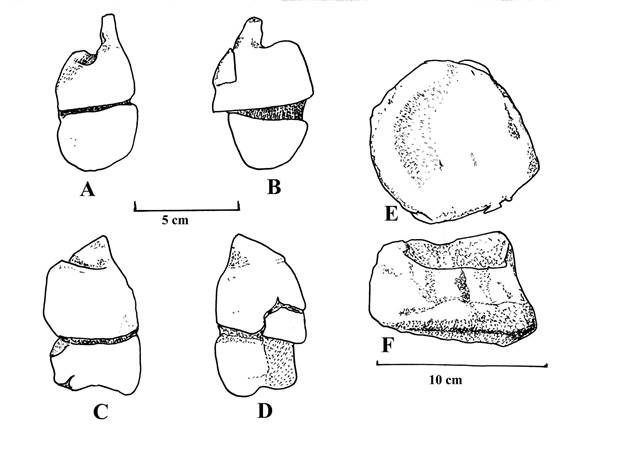
Vertebrae of CPC 272: A-D) dorsal vertebra, E-F) caudal vertebra. A) cranial, B) caudal, C, D) lateral views (after Rivera-Sylva et al., 2011); E) cranial, and F) ventral views (after Rivera-Sylva et al., 2018).
Diagnosis as per Rivera-Sylva et al., 2018:…Combination of the following characters: (1) ulna with anterolateral process prominent, tapering and truncated proximally (triangular in lateral view); (2) conical and slightly caudally curved lateral thoracic osteoderm with a longitudinal oval cross-section and vascular grooves on the lateral face only…
Description: Rivera-Sylva et al. (2011) first documented CPC 272, though did not formally name it as a new species. CPC 272 is from one individual.
Dorsal vertebra: The dorsal centrum is amphiplatyan, spool-shaped, and constricted in the middle, which is typical ankylosaur morphology. It is longer and taller than wide. The neural arch is missing except for a portion of the peduncle.
Caudal vertebra: It consists of only a damaged centrum, that lacks the neural arch. The centrum is anteroposteriorly shorter than wide and somewhat hexagonal in proximal view, similar to many nodosaurids (Carpenter pers.com, Rivera-Sylva, et al. 2011).
Left humerus: The left humerus consists of only the distal end. In cross-section, the incomplete shaft is mediolaterally elliptical. The distal condyles are well preserved, and both are nearly equal in size, although the medial condyle extends ventrally beyond the lateral condyle. In contacts, both Edmontonia and Panoplosaurus the medial condyle is smaller than the lateral condyle and does not extend ventrally very much beyond the lateral condyle (Rivera-Sylva et al. 2011).
Left ulna: The ulna lacks its distal third. The olecranon is prominent, in lateral view, it has a wedge-shape and proximally truncated as in other ankylosaurs (Vickaryous et al., 2004). The length/height ratio is 1:1. The olecranon in anterior view forms a broad, inverted right-angled triangle. The proximal end is rounded and not pointed as in Sauropelta. At the base of the olecranon is a well-developed humeral notch that resembles that seen in Niobrarasaurus and Stegopelta, while the radial notch placed lateral to it is shallow and similar to other ankylosaurs (Rivera-Sylva et al., 2011). The anterolateral process is unusually prominent compared with other nodosaurids; it forms an isosceles triangle in outline and has a similar length to the olecranon process (Rivera-Sylva et al., 2018).
Left femur: Only the distal third is preserved. It has a shallow intercondylar groove. The distal end is slightly wider than the shaft, whereas, in Edmontonia, the distal ends flare significantly wider than the shaft. Posteriorly, the lateral condylar ridge (fibular process) is square and prominent (Rivera-Sylva et al., 2011).
Osteodermal spine: An incomplete (missing its base) long and conical horn-like spine with slight caudal curvature. In cross-section, it is longitudinally oval/elliptical (deeper than wide) with a length/width ration of 1:3. Only on its entire lateral face are vascular grooves, which somewhat resembles a ceratopsian horn-core. It is identified as a nodosaurid osteoderm spine based on its conical outline and longitudinal oval cross-section (Rivera-Sylva et al., 2011, Rivera-Sylva et al. 2018).
Comments and comparisons: The anterolateral process of the ulna differs from that of Aletopelta, Edmontonia, Hungarosaurus, Peloropiltes, and UMNH VP 19473, where the olecranon is half the length of the anterolateral process, while in Acanthoplipan gonzalezi the ratio is 1:1 in its prominence compared with the olecranon. The truncated proximal end is similar to Niobrarasaurus (FHSM VP-14855) and Stegopelta (Carpenter & Kirkland, 1998) (Rivera-Sylva et al. 2018).
The osteoderm has a width-length ratio of 1:3, and is longer in respect to its width, than in both Edmontonia and Aletopelta where the ratio is 1:3. Edmontonia thoracic spines are slightly transversely compressed and straight that terminates in a blade (Sternberg, 1928). Aletopelta they are much more laterally compressed, being three to four times longer than wide, with blunt anterior and posterior keels (Coombs & Demere, 1996). CPC 272 closely resembles the Santonian Hungarosaurus and Struthiosaurus from Europe (Ősi & Pereda-Suberbiola, 2017), however, the grooves in CPC 272 are wider than those in the European taxa. Because it was found near the femur it is interpreted as a distal thoracic spine.
Rivera-Sylva et al. 2011 placed CPC 272 as a nodosauridae incertae sedis, Rivera-Sylva et al. 2018 placed Acanthoplipan gonzalezi firmly in the family Nodosauridae.

Vertebrae of CPC 272: A-D) dorsal vertebra, E-F) caudal vertebra. A) cranial, B) caudal, C, D) lateral views (after Rivera-Sylva et al., 2011); E) cranial, and F) ventral views (after Rivera-Sylva et al., 2018).
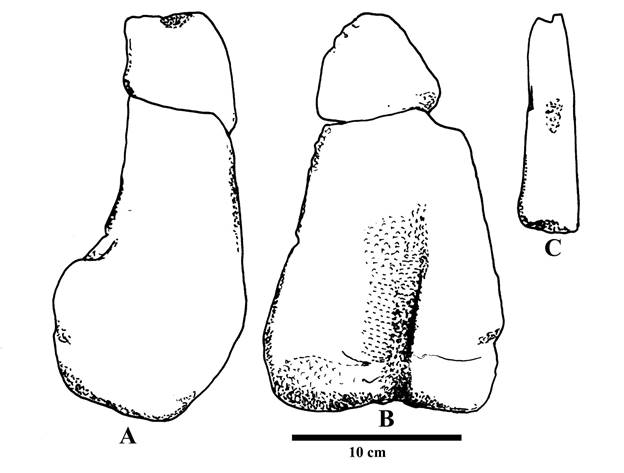
Distal left femur A, B, and rib fragment C: A) right lateral, B) cranial views, and C) rib fragment.
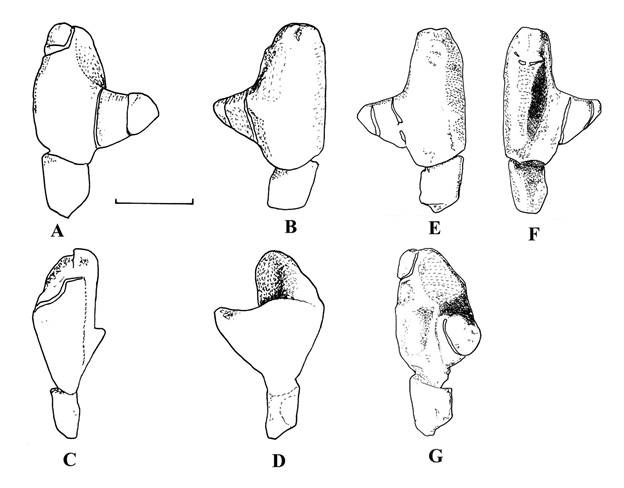
Fragmentary ulna: A) dorsal, B) ventral, C, D) lateral views (after Rivera-Sylva et al., 2011), E) caudal, F) cranial, and G) lateral views (after Rivera-Sylva et al., 2018).

Comparison of left ulna to other ankylosaurids; A) Acantholipan gonzalezi (CPC 272) left ulna in medial view, B) Edmontonia rugosidens (ROM 1215, reversed) left ulna in anterior view; C) UMNH VP 19473 ulna in lateral view; D) Liaoningosaurus paradoxus (IVPP V12560) left ulna in medial view; E) Peloroplites cedrimontanus (CEUM 11347) right ulna in lateral view; F) Hungarosaurus tormai (MTM 2007.25.2) right ulna in lateral view; G) Niobrarasaurus coleii (FHSM VP-14855), right ulna in lateral view, and H) Minmi sp (QMF 181010), left ulna in medial view. Scale bars in 1-c, e-h 10 cm, D equals 1 cm (after Carpenter et al., [1995]), Han et al., [2014], Russell [1940]) (modified from Rivera-Sylva et al., 2018).
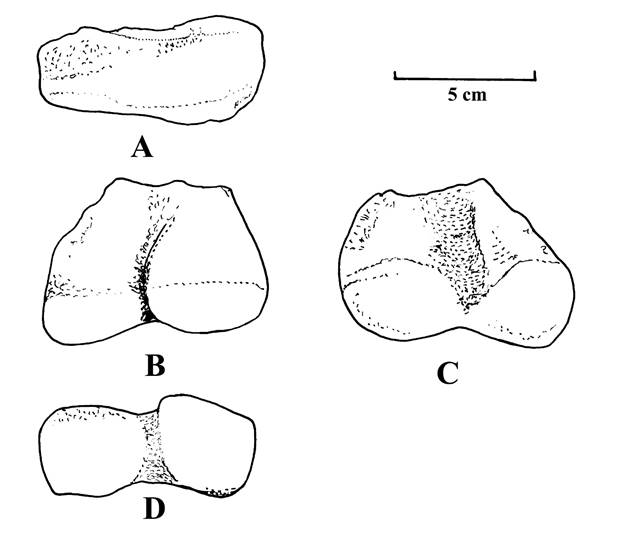
Humerus of CPC 272; A) dorsal, B) anterior, C) posterior, and D) ventral views (after Rivera-Sylva et al., 2011).
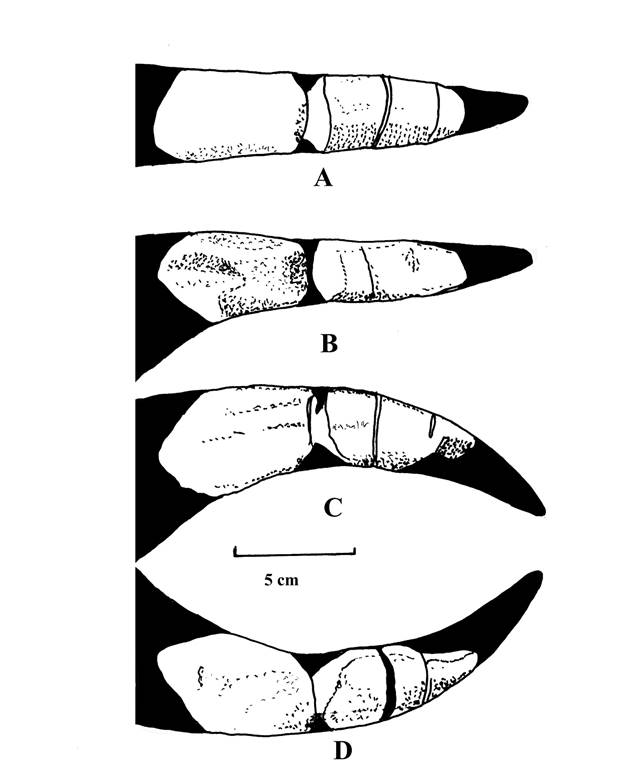
Osteoderm of CPC 272, A) anterior, B) posterior, C) left lateral and D) right lateral (Rivera-Sylva et al., 2011).
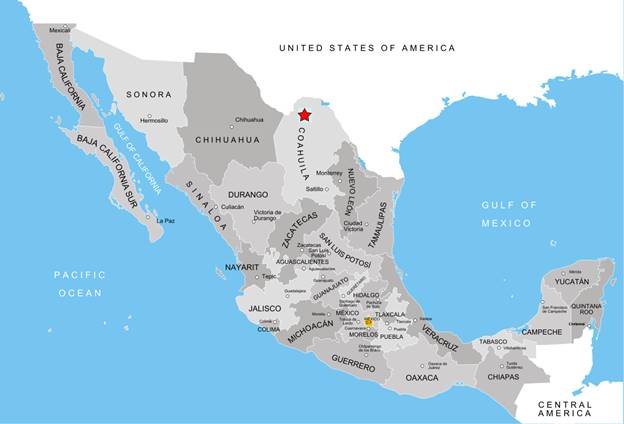
Red star showing approximate area where CPC 272 was discovered.
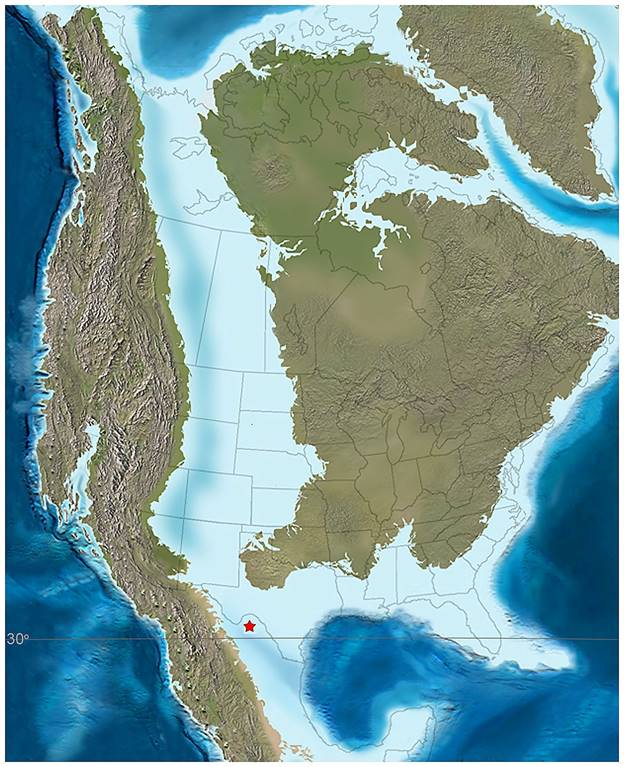
Paleogeographic map showing approximate locality of CPC 272, Laramidia to the left.
(modified from https://plos.figshare.com/articles/_Paleomap_of_North_America_during_the_Late_Cretaceous_85Ma_from_Blakey_2011_/915168/1 )
Bibliography:
Carpenter, K., Dilkes, D., and Weishampel, D. B., 1995, The Dinosaurs of the Niobrara Chalk Formation (Upper Cretaceous, Kansas): Journal of Vertebrate Paleontology, v. 15, n. 2, p. 275-297.
Carpenter, K., and Kirkland, J. I., 1998, Review of Lower and Middle Cretaceous Ankylosaurs From North America: In: Lower and Middle Cretaceous Terrestrial Ecosystems, edited by Lucas, S. G., Kirkland, J. I., and Estep, J. W., New Mexico Museum of Natural History and Science, Bulletin n. 14, p. 249-270.
Coombs, W. P. jr., and Demere, T. A., 1996, A Late Cretaceous Nodosaurid Ankylosaur Dinosauria: Ornithischia) from Marine sediments of Coastal California: Journal of Paleontology, v. 70, n. 2, p. 311-326.
Ford, T. L., and Kirkland, J. I., 2001, Carlsbad ankylosaur (Ornithischia, Ankylosauria): an ankylosaurid and not a nodosaurid: In: The Armored Dinosaurs, edited by Carpenter, K., Indiana University Press, p. 239-260.
Han, F., Zheng, W., Hu, D., Xu, X, and Barrett, P. M., 2014, A new basal ankylosaurid (Dinosauria: Ornithischia) from the Lower Cretaceous Jiufotang Formation of Liaoning Province, China: Public Library of Science (PLOS), One, v. 9, n. 8, 17 pp.
Ősi, A., and Pereda-Suberbiola, X., 2017, Notes on the pelvic armor of European Ankylosaurs (Dinosauria: ornithischian). Cretaceous Research, v. 77, 11-22.
Rivera-Sylva, H. E., Carpenter, K., and Aranda-Manteca, F. J., 2011, Late Cretaceous Nodosaurids (Ankylosauria: Ornithischia) from Mexico: Revista Mexicana de Ciencias Geologicas, v. 28, n. 3, p. 271-278.
Rivera-Sylva, H. E., Frey, E., Palomino-Sanchez, F. J., Guzman-Gutierrez, J. R., and Ortiz-Mendieta, J. A., 2009, Preliminary report on a Late Cretaceous vertebrate fossil assemblage in Northwestern Coahuila, Mexico: Boletin de la Sociedad Geologica Mexicana: v. 61, n. 2, p. 239-244.
Russell, L. S., 1940, Edmontonia rugosidens (GILMORE) an armored dinosaur from the Belly River Series of Alberta: University of Toronto Studies, Geological Series, v. 43, p. 3-28.
Sternberg, C. M., 1928, A new armored dinosaur from the Edmonton Formation of Alberta: Transactions of the Royal Society of Canada, Section 4, p. 93-103.
Vickaryous, M. K., Marayanska, T., and Weishampel, D. B., 2004, Ankylosauria, Chapter Seventeen: In: The Dinosauria, Second Edition, edited by Weishampel, D.B., Dodson, P., and Osmolska, H., California University Press, p. 363-392.